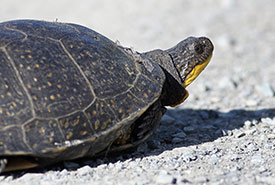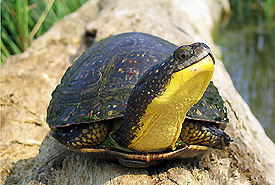A lesson about life in the slow lane

Blanding’s turtle at Emma Young Property, Frontenac Arch, ON (Photo by Mike Dembeck)
I think many of us need a reminder to slow down. With a ground speed maxing out at only a few kilometres per hour, the only option for a Blanding’s turtle is slow. Although it takes them a long time to travel throughout their extensive home range (they nest up to six kilometres from their wetland of origin), life in the slow lane has its advantages. Blanding’s turtles don’t reach sexual maturity until 25 years and can live up to 75 years. Even their habitat is slow and steady; they prefer to live in still, aquatic habitats with lots of plant cover. So how does this species fit into our fast-paced, modern world?
Blanding’s turtle is a threatened species in Ontario. This is due to habitat loss, road mortality and even poaching for the pet trade. In my job, I’m lucky to get up close and personal with Ontario’s smiling turtle, nicknamed for the shape of its face, which gives it a joyful expression.
I’m one of those people who tends to live my life at a fast pace, but nothing makes me mentally slow down more than seeing a turtle cross the road. Despite spending a lot of time in the wetlands of the Frontenac Arch, in Ontario, I’m most likely to see a Blanding’s turtle while driving. When moving between its nesting, summer and winter habitats, this species can travel several kilometres; a feat that often involves crossing roads.
I work as the Nature Conservancy of Canada’s (NCC’s) coordinator of conservation biology for eastern Ontario, and one of my main responsibilities is managing the stewardship work in the sub-region. One morning in mid-summer 2019, I was driving toward Kingston, Ontario, and the day was stacked against me. I was giving a talk on the work that NCC does at Queens University, followed by leading a conference call and creating a field work plan. The day rounded out with the constant pressure of an ever-growing pile of reports on my desk. Taking a minute to calm my mind didn’t seem like an option.

Blanding’s turtle (Photo by Ryan M. Bolton)
But as I crested a hill, I spotted a familiar friend, a Blanding’s turtle, in the middle of the pavement. The road was quiet, and since it was safe to pull over, I got out to help it cross the road. Picking up the turtle gently, I carried it close to the ground, in the direction it was travelling, and safely released it.
The other side of the road happened to be a NCC-protected wetland, and it was one I had spent a lot of time in, removing invasive phragmites. As I stood up and took in the view, I couldn’t help but smile. In that moment, I wasn’t thinking about the endless to-do list in my head. My only job was helping this turtle complete its slow, but important, journey.
The whole interaction took maybe three minutes, but it was enough to calm my mind and remind me how impactful our work is. These moments, no matter how small, connect us to nature. I returned to my car, still smiling, knowing I had just shared a special moment with one of Ontario’s vulnerable species and had helped it on its way.
The Blanding’s turtle is one of 17 species featured in the Nature Conservancy of Canada’s gift giving campaign: Gifts of Canadian Nature. To learn more and to give the gift of conservation this holiday season, click here.




